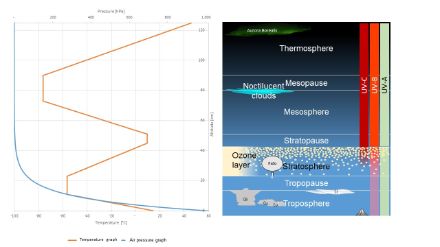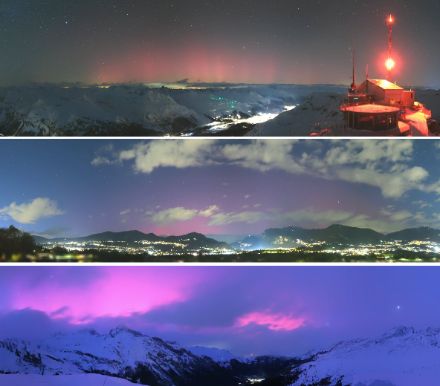Service Navigation
Search
The vertical structure of the atmosphere

Thermosphere
The temperature increase in the thermosphere is mainly caused by the absorption of extreme UV radiation. At these altitudes, conventional temperature measurements are of little use, due to the decreasing particle mass the higher you go. In the exosphere (the layer above the thermosphere), individual gas particles are so far apart that they no longer collide with each other and can even escape into space from this outermost region of the atmosphere.
The phenomenon of polar aurora occurs within the thermosphere. The origin of this phenomenon lies in the Earth’s magnetic field, or rather in the solar particles that reach it. More precisely, the auroras actually occur in the ionosphere, which largely coincides with the thermosphere but also extends several kilometres downwards into the mesopause.
Polar auroras:
Auroras occur as a result of high levels of solar activity, during which the Sun emits large amounts of electrically charged particles (electrons and ions). These particles take around one to five days to reach Earth. The movement of these particles through space is referred to as solar wind.
The particles emitted by the Sun are deflected northwards or southwards by the Earth’s magnetic field above the equator. As they are deflected, the particles are accelerated towards the poles and ultimately transported towards the Earth’s surface over the polar regions. When the solar particles encounter oxygen and nitrogen molecules in the Earth’s atmosphere near the poles, this results in what we perceive as an aurora.
The aurora around the North Pole is called the Aurora Borealis, and around the South Pole, the Aurora Australis.
Auroras usually occur between 100 and 400 km above the Earth’s surface, and in extreme cases can reach up to 600 km. The colour depends on the atom that the solar particle encounters and the energy level of the solar wind:
- Red: mostly observed at altitudes of between 300 and 400 km due to oxygen atoms. This is the colour that is most commonly observed in our latitudes.
- Green: observed at heights of 100 to 300 km, due to oxygen atoms. Overall, this is the most frequently observed colour (limited to high latitudes, due to the height at which it occurs and the curvature of the Earth).
- Pink: observed at an altitude of around 100 km, due to nitrogen atoms.
- Blue and violet: these colours arise due to hydrogen and helium molecules. They are barely perceptible to the naked eye.
The Sun is constantly emitting electrically charged particles, which are ejected into space at speeds of 300,000 to 400,000 m/s. Occasionally, the solar surface is disturbed by coronal holes and sunspots. The former causes a substantial acceleration of the solar wind (700,000 m/s), which can lead to intense aurora activity. In turn, the sunspots that appear on the solar surface lead to more frequent solar eruptions, resulting in solar matter being ejected into space. This phenomenon is known as coronal mass ejection (CME). The arrival of CMEs close to our planet can lead to magnetic storms, causing auroras even in the mid-latitudes.
The Sun undergoes an 11-year cycle in terms of minimum and maximum activity, which can be identified visually by the number of sunspots on its surface. During a phase with minimal activity, the Sun is spotless, whereas during a phase of high activity, dozens of spots cover its surface. During this time, CMEs are also numerous, increasing the likelihood of magnetic storms and intense auroras.
